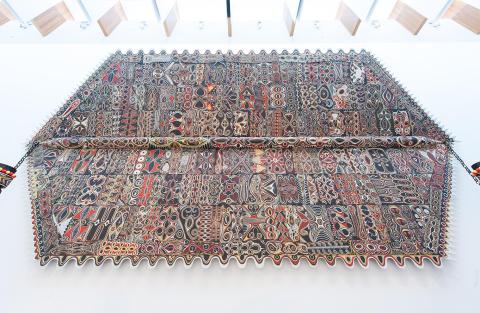ESSAY: Koromb (spirit house) 2012
The carvings and paintings created by Kwoma Arts respond directly to the koromb (spirit houses) found in the Upper Sepik villages of Tongwinjamb and Mino. Each Kwoma village has at least one such koromb, which is a place for the discussion of issues affecting the community and for ceremonial displays and ritual performances. Today these ceremonial events relate to the planting and harvesting of yams, rituals associated with ancestral spirits, and the celebration of important community events.
Like those of the village koromb, the vibrant ceiling created for APT7 comprises over 200 panels. The architectural structure of the koromb has been translated by the artists into an installation using new materials, while retaining its integrity and significance. Each panel is painted with a design from individual artists` clan totems. Represented in this work are the animals, plants, birds and spirit figures associated with four different Kwoma clan groups - Wanyi (cassowary), Teki (dog), Humikwa (bird of paradise) and Guisemb (sea eagle). In a palette of black, white, red and yellow, this vibrant ceiling communicates the energy associated with the spirits housed within. These spirits are more fully explored in the koromb’s sculptural supports, which in this installation consist of six kwat (posts) carved with figurative designs relating to key narratives surrounding Kwoma sikiyawas (spirits).
The participation of Papua New Guinean artists in APT7 is generously supported by Kramer Ausenco.
Connected objects
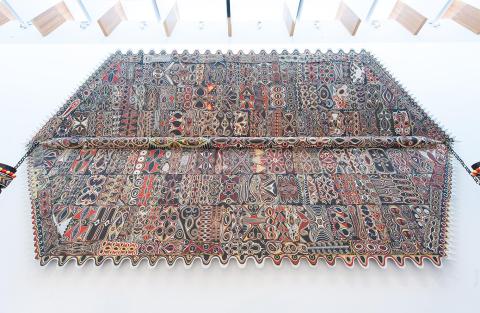
Bilas (ornamentation) from "Koromb (spirit house)" 2012
- PAKIEY, Terry - Collaborating artist
- MAUKOS, Rex - Collaborating artist
- KWOMA ARTS - Collaborative group
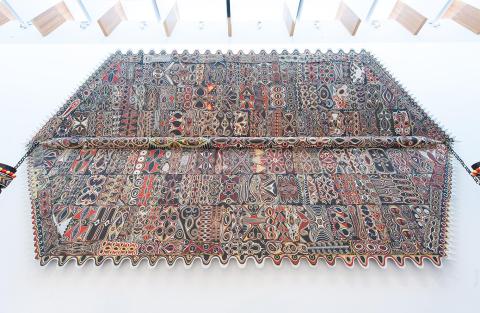
Bi (ceiling paintings) from "Koromb (spirit house)" 2012
- GOIYAP, Simon - Collaborating artist
- WAIAWAS, Anton - Team leader
- APSEPA, Kevin - Collaborating artist
- PAKIEY, Terry - Collaborating artist
- MAKAMOI, Nelson - Collaborating artist
- JIMOK, Jamie - Collaborating artist
- MAUKOS, Rex - Collaborating artist
- KWOMA ARTS - Collaborative group

Showp kwat (support post) from "Koromb (spirit house)" 2012
- WAIAWAS, Anton - Team leader
- APSEPA, Kevin - Collaborating artist
- MAKAMOI, Nelson - Collaborating artist
- JIMOK, Jamie - Collaborating artist
- KWOMA ARTS - Collaborative group
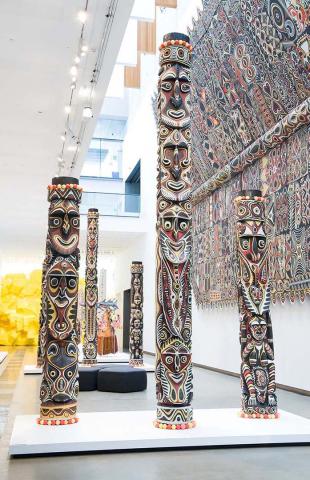
Mes kwat (support post) from "Koromb (spirit house)" 2012
- PAKIEY, Terry - Collaborating artist
- MAUKOS, Rex - Collaborating artist
- KWOMA ARTS - Collaborative group

Nunda kwat (king post) from "Koromb (spirit house)" 2012
- MAKAMOI, Nelson - Collaborating artist
- JIMOK, Jamie - Collaborating artist
- KWOMA ARTS - Collaborative group

Yambi kwat (support post) from "Koromb (spirit house)" 2012
- GOIYAP, Simon - Collaborating artist
- KWOMA ARTS - Collaborative group

Kamba nager (support post) from "Koromb (spirit house)" 2012
- PAKIEY, Terry - Collaborating artist
- MAUKOS, Rex - Collaborating artist
- KWOMA ARTS - Collaborative group

Whoen kwat (king post) from "Koromb (spirit house)" 2012
- WAIAWAS, Anton - Team leader
- APSEPA, Kevin - Collaborating artist
- KWOMA ARTS - Collaboration
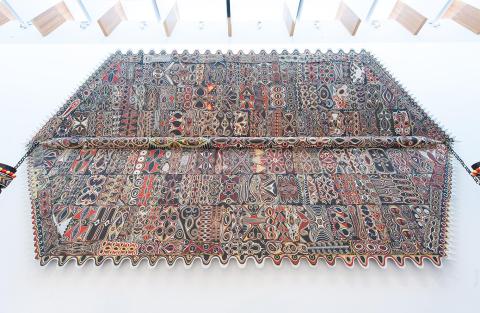
Warangei (decorative edging) from "Koromb (spirit house)" 2012
- GOIYAP, Simon - Collaborating artist
- WAIAWAS, Anton - Team leader
- APSEPA, Kevin - Collaborating artist
- PAKIEY, Terry - Collaborating artist
- MAKAMOI, Nelson - Collaborating artist
- JIMOK, Jamie - Collaborating artist
- MAUKOS, Rex - Collaborating artist
- KWOMA ARTS - Collaborative group

Bi (ceiling paintings) from "Koromb (spirit house)" 2012
- GOIYAP, Simon - Collaborating artist
- WAIAWAS, Anton - Team leader
- APSEPA, Kevin - Collaborating artist
- PAKIEY, Terry - Collaborating artist
- MAKAMOI, Nelson - Collaborating artist
- JIMOK, Jamie - Collaborating artist
- MAUKOS, Rex - Collaborating artist
- KWOMA ARTS - Collaborative group
Metadata, copyright and sharing information
About this story
- Subject
